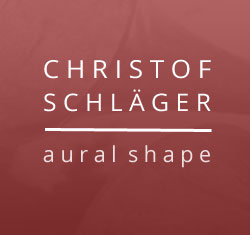|
Work
Urbane Rituale
Description (German)
Christof Schläger lässt sich von Klängen und Geräuschen inspirieren,
die ihm in seiner Lebenswelt begegnen. Zum Bau fast jeder
Klangmaschine weiß er Schläger ein Erlebnis zu berichten.
Die Klangwelt, die dabei entsteht, ist von dieser Inspiration
und auch vom Technischen ihrer Erzeugung inspiriert. Sie umfasst
metallische Klänge, sirrende, schwirrende und pfeifende Geräusche,
Klicksounds, Rasseln und Klingeln sowie durchaus auch Töne;
beim "Schwirrer" zum Beispiel tritt der Geräuschanteil hinter
den Tonhöhenwert zurück. Diese Klang und Geräuschcharakteristik
ergibt sich aus der technischen Konstruktion der Klangmaschinen,
jedoch ohne dass Christof Schläger mit ihnen technische Geräusche
imitieren möchte. Ihre technische Anmutung bildet vielmehr
eine symbolhafte, auch allegorische Dimension der Klangwelt,
indem sie auf die Welt, in der wir leben, verweist. Darüber
jedoch öffnet sich ein Erfahrungsraum, der den Eigenwert dieser
Klänge betont und ihre Schönheit offenbart. In den Kompositionen
Christof Schlägers mutieren die technischen Geräte und Klänge
zu Gebilden einer Fantasie, die völlig Neues entstehen lässt.
Soundmachines
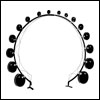
more info
|
Drum-Gate (2016)
PDF
...
Material: steel, rubber membranes, valve block
Weight: ?
Dimensions: length 400cm [13.1 ft]
x height 350cm [=11.5 ft]
|
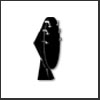
more info
|
Hammerwerk
(2014)
PDF
Hammerwerk consists of four air drums woth eight pneumatically powered hammers for
which the stretched membranes of kevlar -a synthetic fiber of high tensile
strength- over a circular mounting with an internal diameter of 1.50 meters.
Attached to each drum are sixteen hammers each of which are fitted with a
pneumatically operated rotational joint the heads of which covered with
various materials, strike the membrane. The flaming orange color of the
membranes with their small insectile hammer arms gives Hammerwork,
especially when in movement, the appearance of a delicate, organic being.
Material: steel sheets, pneumatic swivel drives, valve islands, control
Weight: 55 kg
Dimensions: height 220cm [=7.2 ft] x width 150cm [=4.9 ft]
|
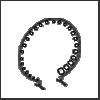
more info
|
Kulong
(2009)
PDF
32 Typewriter magnets strike custom-made
oval metal cylinders. There are two versions: One tuned B gate consisted of a Typedrum
to F#, one tuned G to D.
Material: 32 magnets, steel
Weight: 50 kg
Dimensions: height 300cm [=9.8 ft] x length 380cm [=12.5 ft] x width 80cm [=2.6 ft]
|

more info
|
Typedrum
(2009)
PDF
The clattering backdrop of electric daisy
wheel typewriters has become an acoustic museum’s rarity. This particular sound environment
was revived here. For Typedrum small level arms strike membranes of print foil mounted on
round tires.
Material: 16 magnets, metal, foil
Weight: 40 kg
Dimensions: height 300cm [=9.8 ft] x length 380cm [=12.5 ft] x width 80cm [=2.6 ft]
|
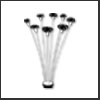
more info
|
Brauser
(2004)
PDF
Motors are mounted on perforated
synthetic foil stretched over eight three-meter-plus high poles. When the motors are
activated they cause the foil to rapidly rotate which generates a robust, clamorous sound.
The eight poles stand on a carrier and the foil, which is red, makes them appear like
long-stemmed plants in a vase.
Material: steel rods, 8 motors, foils
Weight: 20 kg
Dimensions: length 160cm [5.2 ft] x height 330cm [=10.8 ft]
|

more info
|
Chromix
(2001)
PDF
The mechanical principle: Magnetic generators
let V2-A metal sheets resonate. Chromix exists in four executions. Sound is produced by means
of magnets that stimulate the steel sheets’ intrinsic resonances. The metallic sound produced
varies between made by a transformer and that made by a thunder sheet.
Material: 32 magnets, stainless steel-chrome sheets, metal
Weight: 60 kg
Dimensions: length 760cm [=24.6 ft] x height 330cm [=10.8 ft]
|
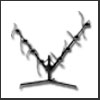
more info
|
Schwirrer
(2000)
PDF
Schwirrer, built in 2000, is based on a
principle similar to that of an organ or flute in which a column of air is caused to vibrate
when air is forced into a tube. The parallel fluting within the tube generates standing waves of
air similar to the aquatic action in a small brook where extending from the banks crosswise
overlapping waves are formed on the surface of the water.
Material: steel, cable conduits and pipe bends, 8 sewing machine motors
Weight: each instrument 80 kg
Dimensions: height 350cm [=11.5 ft] x length 700cm [=23.0 ft]
|
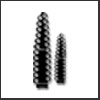
more info
|
Telewald
(1999 / 2013)
PDF
72 telephone bells have been mounted on a
slightly concave carrier of 3.10 meters in height and are struck by magnets. In addition to
these standard telephone bells, the artist also uses prepared bells in the form of flat metal
discs, which produce a rattling sound.
Material: steel profiles, 576 bells
Weight: each object 15 kg
Dimensions: height 310cm [=10.2 ft] x length 45cm [=1.5 ft]
|
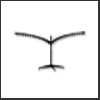
more info
|
Whupi
(1998)
PDF
Metal membranes in small metal
boxes are vibrated. On the arms, which can have a span of up to 16 meters [=52.5 ft],
sound moves up through the space.
Material: 64 boxes, steel pipe, metal sheets, flexible tubes
Weight: 60 kg
Dimensions: length 1600cm [=52.5 ft] x height 40cm [=13.1 ft]
|
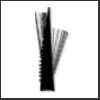
more info
|
Standzeit
(1994)
PDF
The mechanical principle of sound generation.
Disassembled bell magnets strike steel spring rods.
Material: 32 bells, metal pyramid, spring rods
Weight: 29 kg
Dimensions: heigth 250cm [=8.2 ft] x width 100cm [=3.3 ft]
|
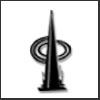
more info
|
Federine
(1994)
PDF
A steel pyramid serves as the platform for Federine.
Its construction was inspired by the droning and groaning noises of the springs of a garage door.
Vibration of similar springs is activated by seven drills set in motion by motors. Schläger furthermore
mounted poles and wires to the pyramid which are struck by 25 magnets from spinning machines.
Material: 25 magnets from spinning machines, 7 motors, steel, garage door springs
Weight: 110 kg
Dimensions: height 257cm [=8.4 ft] x width 130cm [=4.2 ft]
|
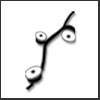
more info
|
Knackdosen
(1993)
PDF
Connected by a cable electromagnetic signal
generators are mounted at intervals of 0.5 meters. Close-circuited, they generate a cracking
sound. The 32 meter long cable of the Crackboxes chain can be arranged in various ways. Schläger
places the chain either inconspicuously in the room or he constructs with them objects on carriers.
Material: transducer, signal source, cable
Weight: 15 kg
Dimensions: length 3200cm [=105 ft]
|
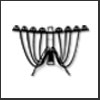
more info
|
Sirenen
(1989)
PDF
Air passing through rapidly rotating
perforated discs produces a characteristic siren sound. The siren consists of eight discs,
which can be triggered by eight throttle flaps and 16 motors. Wind machine blowing air
into the valve box. The valves distribute the air to the eight hoses.
Material: steel, tubes, 8 hoses, 8 valves, 8 throttles, 16 motors
Weight: 140 kg
Dimensions: height 240cm [=7.9 ft] x width 350cm [=11.5 ft]
|

more info
|
Klangmaschine
(1984)
PDF
The first sound machine was constructed
over thirty years ago. It consisted of three elements: The sound sculptures named Klangmuschel
(Sound Shell), Gewittersäule (Thunderstorm Column), and Sirene. All have mechanical sounders
and can be activated directly by switches and regulators. The Sound Shell has a rotating
disc with a scratcher, a rotating ring consisting of springs, a hammer, sounders, magnet horn,
and drilling motor. The Thunderstorm Column has rotating chains on two garage gate springs,
a metal rod carousel, a buzzer, and a beater. Sirene consists of a wind machine and three
perforated disc motors.
Material: metal bodies, motors, blowing machines, switches, controls
Weight: 150 kg
Dimensions: Sirene 140cm [=55.1 in.], Sound Shell 120cm [=47.2 in.], Thunder Storm
Column 250cm [=98.4 in.], control panel 90cm [=35.4 in.]
|
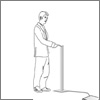
more info
|
Selektor
(2004)
PDF
...
Material:
Weight: 6 kg
Dimensions: height 80cm
|
|
